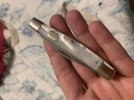Nobody can guarantee that your celluloid knife won't deteriorate. It may not run away for decades, it might go next week. Think of this: With all of the money in and around Hollywood, nobody has figured out how to preserve flammable film stock. All that can be done is to transfer the images to stable media.
Some things may help. Cool and dark is good. Acid trapping materials like calcium carbonate, sodium bicarbonate, or zeolite can slow the reaaction that causes deterioration. Free air movement may help. The problem is the acidic fumes that the celluloid gives off. Allowing the fumes to accumulate will only aggravate the problem.
The only sure way to prevent damage is to store celluloid away from non-celluloid knives, and away from each other. It won't prevent the celluloid knife from running away, but it will prevent damage to other knives.
Storing it in plastic won't prevent deterioration, and may accererate it once it starts. Don't worry about further damage once the process starts. Once the celluloid starts deteroirating, nothing will stop it.
I've had a few knives deteriorate. One in particular was bad. It was in a drawer that didn't get opened for something like six years. There was basically nothing left of the scales, and it was a corroded mess. Worse yet was the damage caused to the rest of the knives in the drawer. I don't buy celluloid any more, haven't for years. The knives I still have are kept well apart from each other and everything else of value.
Lesson learned... Keep celluloid away from everything else, and away from other celluloid knives.
For what it's worth, I doubt your Bulldog is celluloid. It's impossible to tell from pictures, but I'd bet it's acrylic. Search the interwebs, there are non-destructive tests you can do to find out for sure.


